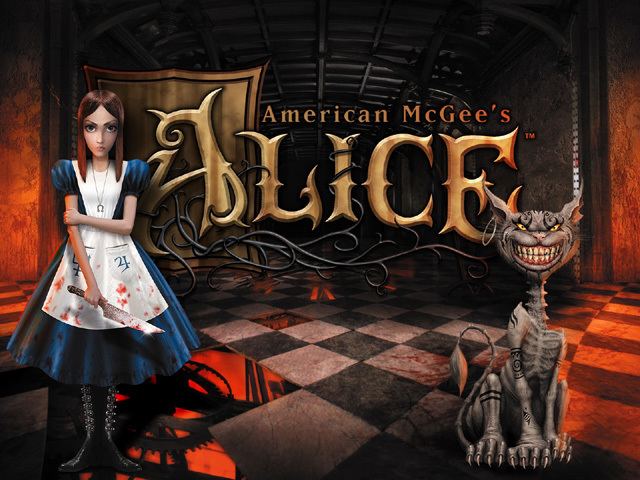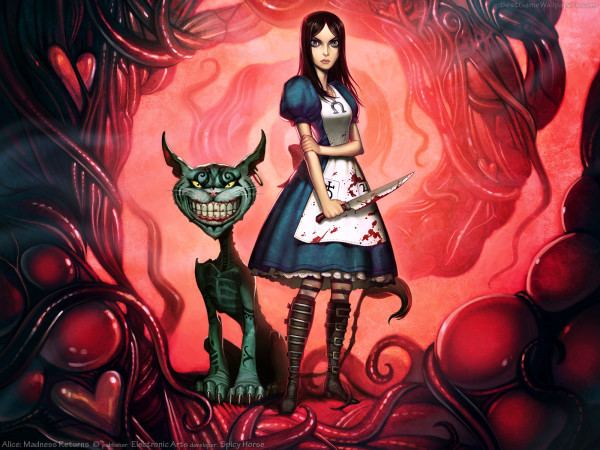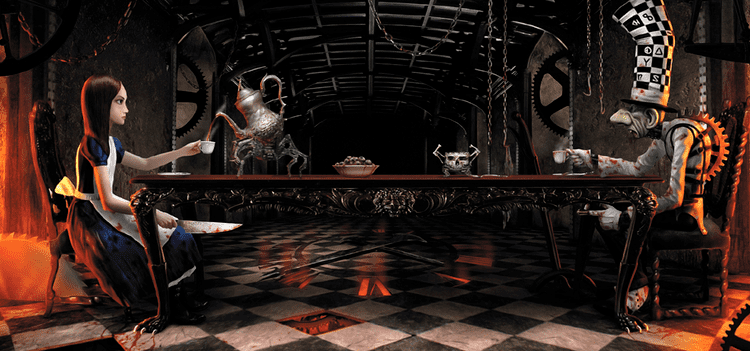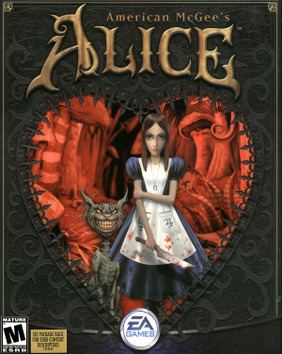8.4 /10 1 Votes
9.4/10 IGN Initial release date 6 October 2000 | 7.3/10 GameSpot Producer(s) R. J. Berg | |||||||||||||||||||||||||||||||||
 | ||||||||||||||||||||||||||||||||||
Programmer(s) Pater Mack, Darin McNeil, Joe Waters Similar American McGee games, Horror games, Other games | ||||||||||||||||||||||||||||||||||
American mcgee s alice game movie all cutscenes hd
American McGee's Alice is a third-person psychological horror action video game released for PC on December 6, 2000. The game, developed by Rogue Entertainment and published by Electronic Arts, is an unofficial sequel to Lewis Carroll's Alice novels. It was designed by American McGee and features music composed by Chris Vrenna.
Contents
- American mcgee s alice game movie all cutscenes hd
- Pc longplay 588 american mcgee s alice
- Setting
- Plot
- Characters
- Development
- Music
- Film adaptation
- Animated short films
- Reception
- Sequel
- References

The game uses the id Tech 3 engine first used in Quake III Arena. A PlayStation 2 port was in development but was canceled. A sequel, Alice: Madness Returns, was released June 14, 2011. Downloadable ports of the game for PlayStation 3 and Xbox 360 were also made to coincide with the sequel's release as a free download with brand new copies.

Set years after Alice's Adventures in Wonderland and Through the Looking-Glass, the game features an older, more cynical and macabre incarnation of Alice. As of 22 July 2010, American McGee's Alice has sold over 1.5 million copies.

Pc longplay 588 american mcgee s alice
Setting

The game's setting presents a considerably more macabre rendition of Wonderland than seen in Lewis Carroll's original portrayal. Wonderland, being a creation of Alice's mind, has been corrupted. Alice's primary objective is to save Wonderland, and in doing so, save herself.
Plot
Shortly after Through the Looking-Glass, and What Alice Found There, at the age of seven, Alice Liddell witnessed the death of her family in an apparently accidental fire that broke out in her home, which was destroyed in the blaze. Suffering from survivor's guilt, Alice began to lose her grasp on reality and was ultimately sent to Rutledge Asylum, where she is observed and treated by Dr. Heironymous Wilson for her catatonia. Alice's only possession in Rutledge is a stuffed rabbit. Ten years after Alice was committed to Rutledge, she finds herself sucked back into a Wonderland that has been twisted.
The White Rabbit summons Alice to aid a radically altered Wonderland, which became a twisted version of itself as it came under the horrible rule of the Queen of Hearts. The Cheshire Cat serves as Alice's companion throughout the game, frequently appearing to guide her with cryptic comments.
When Alice falls down the hole, she finds herself in the Village of the Doomed. This network of tunnels and caves is the home of the Torch Gnomes, and is patrolled by the Queen of Hearts' card guards. Beyond the subterranean village is the Fortress of Doors, where the main attraction is a school of insane children. Within the school lies an ancient book of recipes for magic potions, as well as the ingredients for one concoction in particular which will be useful to Alice.
Beyond the fortress and across a rough, uncharted landscape lies the Vale of Tears, where Alice's friends Bill McGill and the Mock Turtle reside, along with the Duchess. A giant river runs throughout the gloomy, mist-shrouded landscape, and another aquatic location is accessible through a well inside Bill McGill's house. The well is sealed until the Duchess is slain.
On the other side of the Vale of Tears lies Wonderland Woods, one of the largest regions in the game. The woods are initially filled by ponds, cliffs and jump mushrooms, but much deeper into the woods is a region of rock and magma. This section leads to several new regions including the Cave of the Oracle, the Pale Realm, the Jabberwock's Lair, and the Majestic Maze. The Cave of the Oracle is home to a wise entity that is revealed later to be the Caterpillar.
The Pale Realm makes a transition to the surface of a chessboard, as delving further into this area leads to the White Castle of Looking Glass Land, which is home to life-size chess pieces; the White pieces join Alice in the fight against the Red pieces, a deviation from her normally unhelpful "allies" from earlier portions of the game. Alice is twice transformed into a chess piece herself to pass certain obstacles.
Following this is a distorted version of Rutledge Asylum (where Alice has been incarcerated since her parents' tragic deaths). It is run by Tweedle Dee and Tweedle Dum and also houses the Mad Hatter's laboratory.
The path to the Jabberwock's Lair leads into the Land of Fire and Brimstone, a volcanic region of Wonderland and a reminder of the fire in which her family died. It is here that the terrible Jabberwock—a semi-mechanized servant of the Queen of Hearts and the incarnation of Alice's guilt—resides, in the remains of Alice's old home.
The Majestic Maze ends on the road to Queen of Hearts Land, a region heavily guarded by card guards, boojums, and other members of the Queen of Hearts' personal army.
Queensland is the final province of Wonderland. In it lies the Heart Palace from which the Queen of Hearts commands. Tentacles and other repulsive appendages are seen protruding from every organic wall in this area, and numerous areas even resemble body parts, giving the impression that Alice is travelling through her own body.
Characters
The game's characters are generally based on the inhabitants of Lewis Carroll's original novels, but they do not demonstrate the same identities. Many of them are warped incarnations of their conventional selves. The casebook of Heironymous Q. Wilson (a supplement included with the game and written from the point of view of Alice's doctor) suggests that many of the characters Alice encounters in Wonderland are symbolic of real life people who get through to the catatonic Alice in some way. Other characters within the game are metaphors for Alice's own feelings, and because she is unhappy, they have become twisted. Some people (Cheshire Cat, White Rabbit) help her; others (Mad Hatter, Queen of Hearts) try to cause pain, first by taking away those she loves and then by taking her down with them.
Development
After leaving id Software, Creative Director American McGee was inspired to design a game that did not involve space marines, guns, aliens and outer space, which were the common themes in the Doom and Quake series. McGee also stated that listening to songs like the remixed version of The Crystal Method's Trip Like I Do (sampled from The Dark Crystal) and Rob Zombie's Living Dead Girl helped to further inject tone into the story and characters as the idea formed.
Electronic Arts licensed Ritual Entertainment's Heavy Metal: F.A.K.K.² engine, which is in turn a modified Quake III Arena engine. The most notable changes in the engine include the use of the Tiki model system, which enables the engine to use skeletal animation among other things, the Babble dialog system which enables lip synching of audio with character animations, dynamic music system, scriptable camera, particle system and extended shader support. The changes implemented to the engine for Alice remained minimal however. The game's .bsp files even retain F.A.K.K.²'s headers, albeit sporting a different version number.
An early version of the game featured the ability to summon the Cheshire Cat to aid the player in battle. Though this feature was removed from the final product, beta screenshots of this version do exist online. In the final product, the player can press a button to summon the Cheshire Cat at any time, though he merely provides cryptic advice on the current situation, and does nothing to aid Alice if she is being attacked. An Alice port for the then-unreleased PlayStation 2 was also in development but was later cancelled, which caused Rogue Entertainment to shut down, another decision which angered American McGee and resulted him leaving EA "in frustration." The game's retail release was also noticeably less gory than the demo that had been released earlier.
The game's box art was altered after release to show Alice holding the Ice Wand instead of the Vorpal Blade, and to reduce the skeletal character of the Cheshire Cat's anatomy. EA cited complaints from various consumer groups as its reason for altering the original art, though McGee stated the alteration was made due to internal concerns at EA. A third version of the box art has Alice holding the Cards in her hands instead of a knife or wand.
Alice was EA's first M-rated game, which McGee fought to obtain it because he did not want an Alice product to be sold in Christmas and confused parents thinking it was for their kids. However, in a 2009 interview, McGee regretted the decision because he felt the violence in the game did not warrant for an M-rating and that consumers should buy their products responsibly and to refer to the ESRB beforehand.
Alice has grown in value and become a collector's item since its release, with new copies selling for $100–200 on auction sites and used copies selling for close to $100. The game is prized in the order of its release artwork with the Vorpal Blade version being valued, followed closely by the Ice Wand release and, finally, the comparatively innocuous Hand of Cards version.
In 2010, a real-world replica of the fabled Vorpal Blade was released to commemorate the 10th anniversary of the game.
Music
All of the music created for the official American McGee's Alice soundtrack was written and performed by Chris Vrenna with the help of guitarist Mark Blasquez and singer Jessicka. Most of the sounds he used were created using toy instruments and percussion, music boxes (in a short documentary about the making of the game that appeared on TechTV, the music box used appears to be an antique Fisher-Price music box pocket radio), clocks, doors, and sampled female voices were manipulated into nightmarish soundscapes, including instances of them laughing maniacally, screaming, crying, and singing in an eerie, childlike way.
The music lends an eerie and horrifying feeling to the world Alice is in. The Pale Realm theme, as well as the track "I'm Not Edible", features the melody of the chorus of a popular children's song, "My Grandfather's Clock". In addition, there are many instances of the ticking and chiming of clocks being used as a musical accompaniment.
Marilyn Manson was originally involved scoring the music for the game. His composition has been described by American McGee as "very cool" and having "a very beautiful Beatles-in-their-harpsichord-and-Hookah-pipe-days-sound to it." Manson's contributions persisted into the final product, notably the influence of alchemy and the character of the Mad Hatter whose adaptation was somewhat influenced by him; for a time Manson was considered for the voice of the Hatter. Manson has indicated that the same music may be used in his forthcoming film Phantasmagoria: The Visions of Lewis Carroll.
American McGee's Alice Original Music Score was released on October 16, 2001 by Six Degrees Records. It features all twenty original compositions by former Nine Inch Nails live drummer and studio collaborator Chris Vrenna with vocals done by Jessicka Addams of Jack Off Jill and Scarling.. It includes a previously unreleased theme as well as a remix of "Flying on the Wings of Steam".
Film adaptation
In December 2000, director Wes Craven signed on to develop a film adaptation of the game, with screenwriter John August hired to adapt the game for the big screen. American McGee had begun negotiations with Dimension Films 10 months before, with the studio committing to the project before Craven's signing. In September 2001, August explained that he had turned in a script treatment for Alice and was not attached to develop fuller drafts for the film adaptation. In February 2002, Dimension Films signed brother screenwriters Jon and Erich Hoeber to write the screenplay for Alice. In July 2003, the brothers announced that they had completed the script for the film adaptation.
In 2004, the project moved from Dimension Films to 20th Century Fox, but in 2005 Universal Pictures acquired the rights. As of June 2008, producer Scott Faye indicated the film was in "turnaround" from Universal. He admitted that the script needed development, but would be used to attract the attention of a new studio. At one point the film rights were reported to have been owned by Sarah Michelle Gellar, a self-confessed fan of the game, who noted in 2008 that she's "not giving up" on the film, but a few months later she was reported to have left the project.
In 2013, with the success of earning the funds to produce Alice: Otherlands, McGee stated his desire to continue to work on the possibility of adapting the series into a feature film on Kickstarter. On February 17, 2014, McGee announced that he and his team have secured a British screenwriter to write the film's script. On April 16, 2014, he assured fans that the film is still in production and is currently working with a producer in Hollywood who they have licensed the rights from, but has run into a few difficulties along the way.
On July 10, 2014, McGee informed fans that the progress on the feature film has come to a temporary halt. McGee stated that he has secured the rights only to develop the feature film's story and production, and must acquire the film rights completely before proceeding further. He is currently speaking with potential investors and financiers to gather the required funding, $400,000. On January 8, 2015, McGee stated that negotiations for the feature film have gone on a hiatus, and will not resume until May.
Animated short films
In June 2013, American McGee was given the opportunity to buy back the film rights which were originally sold several years prior. Through Kickstarter, McGee managed to fund the cost of the film rights ($100,000) and another $100,000 for the production of the shorts. In August, the project was successfully funded with an extra $50,000 (used to fund the voice acting of Susie Brann and Roger L. Jackson). The project has been titled Alice: Otherlands.
Reception
The game was ultimately released on December 5, 2000, receiving praise for its visuals; the graphics were very elaborate for their time. Many levels depict a world of chaos and wonder, some reminiscent of the inside of an asylum or a madhouse, visually linking Wonderland to Alice's reality. The exterior views of Wonderland show the Queen of Hearts' tentacles dipping out of buildings and mountain sides, especially in Queensland. Alice received an average review score of 85 out of 100 from Metacritic and 82.09% from GameRankings, with IGN giving the game 9.4 out of 10 and GameSpot giving it 7.3 out of 10, saying, "While you'll undoubtedly enjoy the imaginative artwork, you might end up disappointed with just how straightforward the underlying game really is."
In her article “Wonderland’s become quite strange: From Lewis Carroll’s Alice to American McGee’s Alice,” literary critic Cathlena Martin argues that the game “provides a reinterpreted version of Alice and the whole of wonderland that may have some players questioning which aspects are from Carroll and which are from McGee, thus potentially leading to a rereading of Carroll through the darker lens of McGee’s Alice. This reinterpretation of Alice shows the versatility and mutability of the story across time and discourse.” Martin also notes that the game is successful largely in part to the narrative structure of Carroll’s tales, which are built around games - cards and chess - themselves.
Sequel
As the plans for the movie adaptation of American McGee's Alice started to take longer and longer, in 2007 interest at Electronic Arts rose in a remake of the game and work was started on a sequel. On 19 February 2009, EA CEO John Riccitiello announced at D.I.C.E. 2009 that a new installment to the series is in the works for Xbox 360, PlayStation 3, and PC.
It was developed by Spicy Horse, who recently worked on American McGee's Grimm. Two pieces of concept art were also released, depicting Alice and large allied birds fighting an oversized, semi-mechanized snail and its children on top of a lighthouse, and Alice swimming in a pond, with the Cheshire Cat's face in the background.
In November 2009, a fan-made video based on the Alice 2 announcement was mistaken by gaming websites as a teaser trailer for the game. In it, Alice is in therapy after a relapse nine months after the events of the first game, and appears to hallucinate an image of the Cheshire Cat in place of her doctor.
On 15 June 2010, EA filed a trademark on the name Alice: Madness Returns, the suspected sequel to American McGee's Alice. While the sequel was formally announced via press release on 19 February 2009, the sequel's title was confirmed during the EA Studio Showcase the following day.
The game was finally released on June 14, 2011, in North America, June 16, 2011, in Europe and June 17, 2011, in the United Kingdom under the title Alice: Madness Returns for PC, MAC, Xbox 360, and PlayStation 3. The Xbox 360 and PlayStation 3 versions came with a redemption code that gave the player a free download of American McGee's Alice from each console's online store.
